Year: 1997
Directed by: Albert Pyun
Written by: Albert Pyun, Ed Naha
IMDB Reference
Degree of Cyberpunk Visuals: Low
Correlation to Cyberpunk Themes: Medium
Key Cast Members:
Rating: 5 out of 10

Overview: In this strange apocalyptic tale, most all the humans have died out and now two different groups of androids spend their time killing one another. Unfortunately it appears as if the humans are returning, so they need to find weapons to protect themselves. In one western town, these two groups have reached a stalemate while looking for a hidden “treasure” stash of guns and ammo. Along comes the lone warrior, Bruce Willis (Last Man Standing), er, I mean Clint Eastwood (Fistfull of Dollars), er, I mean Toshirô Mifune (Yojimbo), er, I mean Rutger Hauer - only this time he’s a cross-over android with parts from both rival robot types. Did I mention that he’s fast with his whatever the fuck that gun-looking thing is at his side?
If you know any of these movies, you know the plot here. Some parts are done decently, but others could really be improved. In any event, Omega Doom wins on low-budget style points while it loses out on about 10 minutes of missing explanations. Why do the androids need water? Why do they breath air? Why do they both fear death but seem to be forced to follow their programming? More importantly, why can androids ignore their programming when their emotions are heightened in key scenes? Is this the same reason that my computer uses to crap out when I’m under an intense deadline?
The Bottom Line: Not a high quality picture, but maybe not quite as bad as others are saying. There are some interesting fighting scenes, and I find western cyborg films appealing. And truly, for as low budget as this movie was, Pyun produced at least a semi-watchable product.
In another advance towards a real man-machine interface, the US Army is experimenting with connecting neuro-physiological sensors to soldiers to assist them in cognition and sensemaking during tense warfare situations:
The augmented cognition system uses neuro-physiological sensors that assess a warfighter’s attention by measuring and recording brain activity and body responses, including heart rate, and adapting to his preferred learning style.
Using that data, the system will then influence the way the soldier gets information, according to a Jan. 17 statement from the Army’s Natick Soldier Center in Natick, Mass. The technology will help individual warfighters determine the most important information available and decide the best course of action in varying environments.
“The technology we are developing will ultimately help warfighters when they are faced with information overload, especially under stress, and will significantly improve mission performance,” said Henry Girolamo, the Natick Soldier Center’s DARPA agent for the Army’s Augmented Cognition Program.
This truly is an example of cognition assistance outside the body a la Clark’s Natural Born Cyborg book, and is definitely a move towards more fully integrated man-machine entities.
This post has been filed under News as Cyberpunk by SFAM.
In searching around Technorati for the term “cyberpunk,” I found this little tidbit on a live journal blog. Don’t look now, but it looks like Robocop is coming to Korea in 5 years.
This from the Korea Times:
“By the 2010s, Korea is expecting to see robots assisting police and the military, patrolling the neighborhoods and going on recon missions on the battlefield.
The Center for Intelligent Robots on Monday said the state-backed agency plans to check the feasibility of security robots by convening a 40-member planning committee late this week.
“If the robots prove to be viable technically and commercially, we will be able to begin developing them late next year,” said Lee Ho-gil, head of the center.
When completed, the outdoor security robots will be able to make their night watch rounds and even chase criminals, according to Lee. “
Any chance we could get someone to send them a copy of the movie?
This post has been filed under News as Cyberpunk by SFAM.
Year: 1995
Directed by: Mamoru Oshii
Written by: Kazunori Itô, Shirow Masamune (Manga)
IMDB Reference
Degree of Cyberpunk Visuals: Very High
Correlation to Cyberpunk Themes: Very High
Key Cast Members:
Major Motoko Kusanagi: Atsuko Tanaka
Batô: Akio Ôtsuka
Section 9 Department Chief Aramaki: Tamio Ôki
Togusa: Kôichi Yamadera
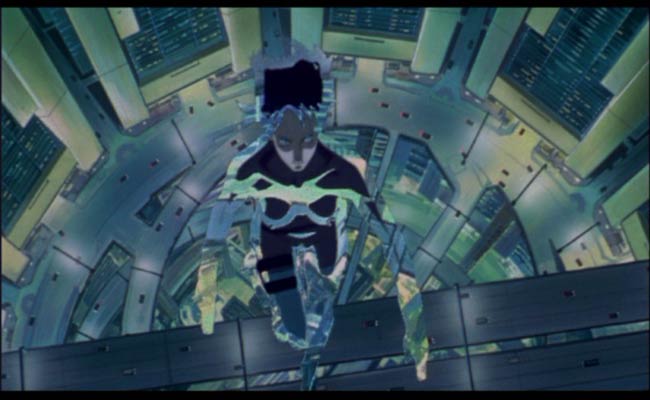
And where does the newborn go from here…the net is vast and infinite…
Overview: After Akira, a case can be made for Ghost in the Shell being the most influential anime ever. While Akira was the first anime to crack international markets, GITS rose anime to something “real,”, and opened the doors for events like Disney’s pursuit of Miyazaki, and eventually, the truly incredibly pace of anime we see today. More important for cyberpunk films, GITS provided a myriad of thoughts and visuals that have been expanded upon in virtually all subsequent cyberpunk animes. James Cameron refers to GITS as the first truly adult animation film to reach a level of literary and visual excellence.” In addition to a wonderfully complex and introspective story, we get heart-thumping, realistic action, all served up with some incredibly revolutionary animation techniques that places GITS on a juicy platter for all to enjoy.
~ Fair warning - there are a few plot spoilers below in the matrix discussion - I simply couldn’t write this, especially with linkages to the Matrix without including an interpretation of the ending of GITS. ~

GITS shows us a very realistic looking near future set in the year 2029. The visuals are intricately detailed and depict grunge settings next to the highly sanitized corporate world. In 2029, people have the ability to augment their bodies with cybernetic replacement parts. In some cases, people have almost fully replaced their human bodies, leaving only their brain encased in a cyborg shell. The brain is even augmented with hyper-intelligent access to knowledge and communication packages. But the person, and we use that term loosely now, still has a ghost, or soul if you will - an emergent property of life that separates a human from a robot. Even though the majority of their human material is replaced with a cyborg-like shell, if the individual retains their ghost, they still retain their personality and individuality - their humanity if you will.
This cyborg shell is not the same as a robot. The limbs and body still communicate with the brain in a digital nervous-system-like operation. If we include Masume Shirow’s vision (the writer for GITS), the cyborg’s sexual parts are even fully functional. This means that in essence, their cyborg shell aids in the creation of an individual’s ghost. While this is terrific, a downside is the ability for evil-doers to engage in Ghosthacking - or the taking over of someone’s perceptual control, or worse, augmenting their artificially enhanced memory.
The story centers on Major Motoko Kusanagi, an almost fully mechanically enhanced cyborg secret operative working for Section 9 - Japan’s anti-terrorism division. As the movie progresses Motoko and her cyborg partner, Batau start to uncover a plot involving another ministry that seems to be engaged in a cover-up. Eventually, we find that this cover-up involves a seemingly nefarious hacker named the Puppet Master. In pursuing the Puppet Master, Motoko finds out that all is not what it seems- that in fact the Puppet Master is a sentient program, and never had a body. More interesting, the Puppet Master has been looking for Motoko!
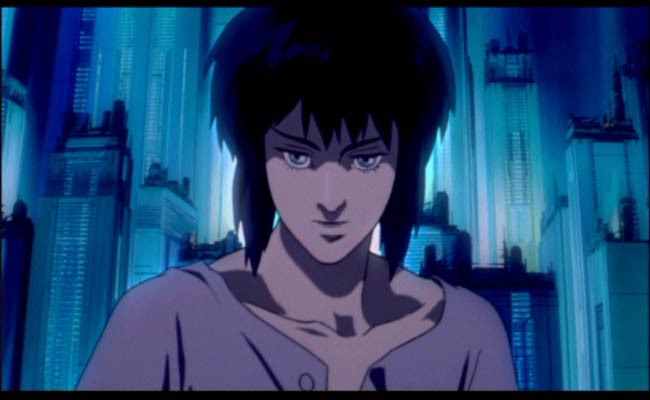
Revolutionizing Anime: Oshii revolutionized animation in GITS with a myriad of new and innovative computer graphics techniques. In short, Oshii pushed the boundaries for state-of-the art animation with GITS. Oshi scanned his animation cells in to a digital system so that he could import them into an editing suite to get all sorts of cool lens effects. For instance, in the above pic, Oshii is able to emulate a contra-pull type effect where the camera moves back, and the lens moves forward. In viewing this, the background expands while the foreground eerily stays in the same place. This works wonderfully for Motoko’s questioning of humanity speech. And this is only one of many interesting used of digital shots. Other techniques include interesting overlays that depict either brain activity or maps, for instance.
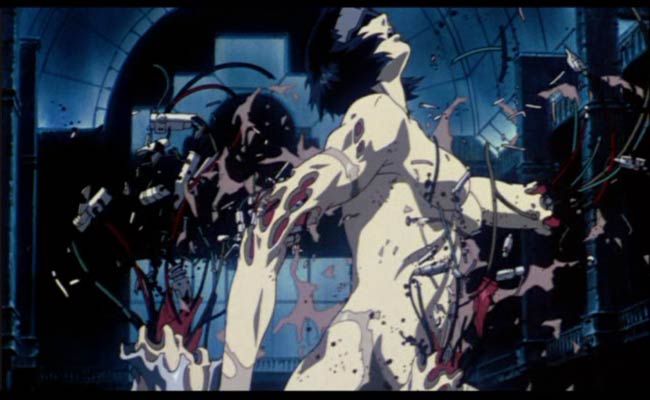
Questioning Humanity: Ghost in the Shell still provides anime’s the best examination in the questioning humanity. GITS is dominated by an ongoing discussion of what it means to be human and really, what it means to be alive. Is Motoko really still human? Even she doesn’t know the answer anymore, and actually questions whether she really has a ghost (how would she be able to differentiate a fake ghost from a real one?). This line of questioning is artfully developed in a way that makes Motoko the character in all of anime that I empathize with the most. You truly feel for the dilemma she finds herself facing.
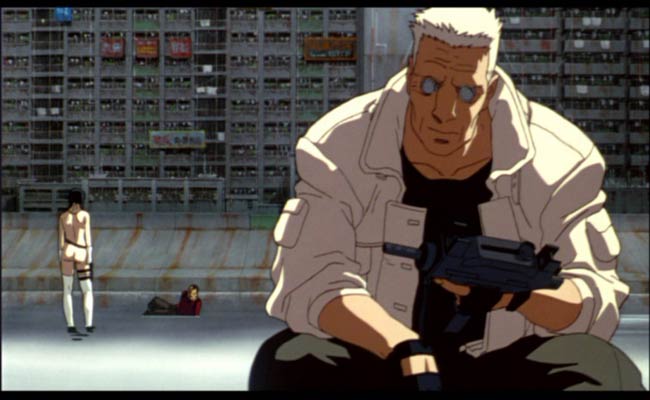
What is the Matrix? If we examine the Matrix, we find that both the visuals and storyline are heavily influenced by Ghost. There are some rather explicit visual “nods” in the first Matrix, including the opening digital sequence, Mr. Smith’s building jump where he breaks the concrete beneath him (this is virtually identical to Motoko pursuing the first puppet victim), and the shooting of the fruit stand where Neo is running near the end. On top of this, we have a reversal of roles in the Matrix, where Neo plays Motoko and Trinity emulates Batau. And again, the Wachowskis make no bones about where their influence came from - they, as much as anyone, have contributed to Ghost’s ever increasing popularity.
In looking at the storyline, we find even more interesting parallels. Ghost in the Shell ends with Motoko merging with the sentient program called the Puppet Master (Project 2501). This allows the Puppet Master produce a diversity of offspring that is simply not possible to do with copies alone. This has a direct parallel to the scifi view of Neo in the above review. While Ghost in the Shell 2: Innocence is the philosophical sequel to Avalon, the Matrix trilogy is just as clearly the sequel to Ghost in the Shell. Whereas GITS ends with this merging of a sentient program with a human ghost, the Matrix expands on this idea. We see Neo take the same journey, but in a very different way. He conducts this symbiotic merging over 3 movies whereas Motoko does this in a matter of minutes. We see Neo, through this merging of sentient program with a human, become the “one” - an omnipotent style being. This characterization is similar to the characterization that Batau gives of Motoko in GITS2 in his dogs and gods versus flawed humans speech.
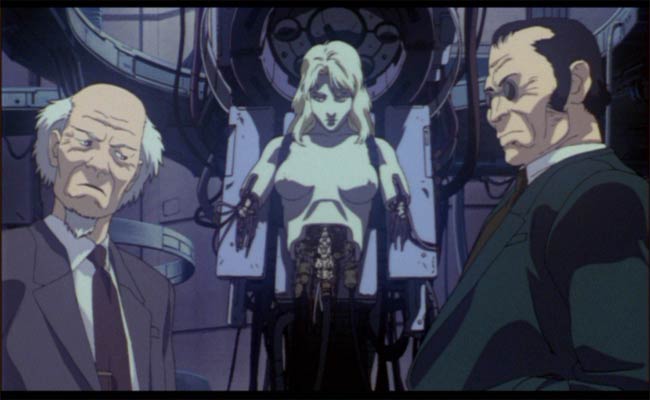
Also interesting is the linkage between the puppet master’s desire to digitally produce offspring with Neo’s reloading of the Matrix. The puppet master discusses this at the end of GITS in the “Life perpetuates itself through diversity and this includes the ability to sacrifice itself when necessary” monologue. If you trace the linkages, Neo’s reloading of the Matrix this is a method for the sentient program portion of Neo to create diversity and offspring. The merging of Neo allows the sentient program to grow and develop in ways simply not possible by itself. Familiarity with Neo’s Ghost allows it to make the changes necessary to correct the errors that build up in the current Matrix that prompt the battery people to disbelieve their surrounding.
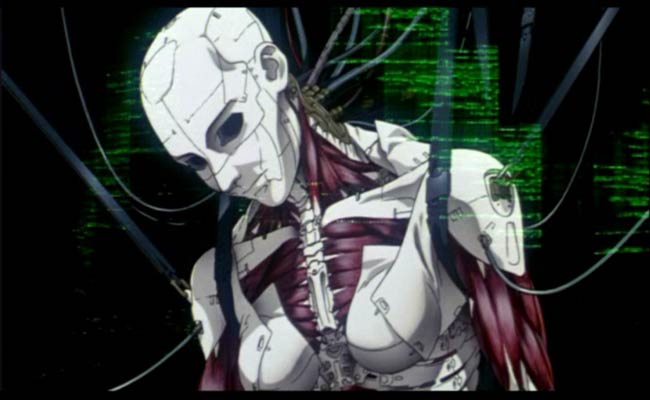
Finally, Ghost gives us a truly interesting vision of the future. We get sound astoundingly realistic and grungy cityscapes that are filled with the most impressive technological horrors. Is it truly a stretch to imagine that technology will augment our physical abilities? This is the bionic man taken to another level. On top of this, if we truly can learn to connect manufactured parts to our nervous system, is it really that far of a stretch to imagine that our brains become augmented? And over time, is it truly a stretch to believe that the line between humanity and robot won’t be blurred? GITS questions these articles of faith in such a believable way that we have seen a shift in our overall thinking on this issue.
The Bottom Line: Truly, even if you ignore all this philosophical stuff, Ghost in the Shell is simply an awesome movie! The action is terrific, the visuals are great, the soundtrack is devine…I could go on and on. If you just see one anime, Ghost in the Shell, still my favorite anime, is hands down the one to get.
Page 2: More GITS Screencaps –>>
~See movies similar to this one~
Tags: cyberpunk movie review anime ghost shell
Year: 1998
Directed by: Ryutaro Nakamura
Written by: Chiaki Konaka
IMDB Reference
Degree of Cyberpunk Visuals: High
Correlation to Cyberpunk Themes: Very High
Key Cast Members:
Lain Iwakura: Kaori Shimizu
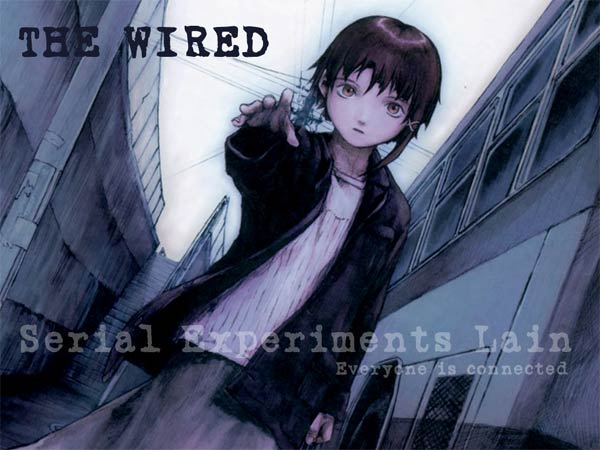
Overview: Serial Experiments Lain is a psychedelic, post-modern cyberpunk series that one wonders how the director ever managed to make. Lain centers on a very shy school girl who slowly begins to figure out that she is not what she seems to be. After getting a computer and connecting to the “wired,” something with is far more expansive than the internet, Lain begins to realize that she may not be human, and that truly, reality and the “self” is exists (or does not exist) on many different levels. As the story progresses, Lain “evolves” in terms of understanding what she is and her place in a very post-modern world. We also get many interesting side stories, including crime, teenage coming of age issues, and dastardly plots.
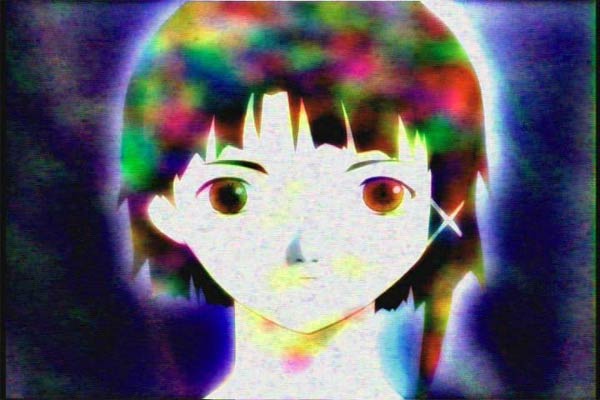
The pacing of Lain is just strange. Lain is NOT an action fest, nor is it by any means straight forward. Lain starts out rather slowly and gets weirder every episode. Truly, the story is told in a very “traditional” post-modern fashion in that we have fragmented vignettes structured in a seemingly random non-linear manner. Lain uses disconnected visuals to continually barrage the viewer with different textures, color schemes, and sounds. Yet over time, it becomes clear that the story is being spunk in seemingly a cyclical fashion, almost as if we are exploring a large Mandelbrot by starting at an outside spiral and slowly working our way around to the big picture. Each fragmented vignette gets added to until, at the end, we have a rather expansive tapestry to explore.

Many different and interesting philosophical ideas. But it is pure philosophical cyberpunk. Many key issues are discussed here, including:
- What constitutes “reality”?
- How real is time?
- What constitutes the “self” as a singular entity?
- What constitutes “God”?
- How are sentient programs different from humans?
- Is there such a thing as collective humanity?
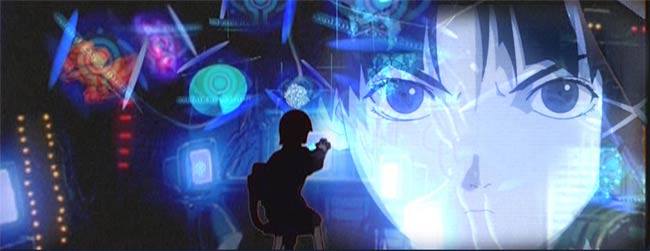
The visuals in Lain really aren’t there to “Wow” us as they are in some animes - instead they are often designed to provoke moods and thought patterns (BTW, there are so many screen caps available, that there was no need to take my own). Among the thought provoking visuals, we get:
- Psychedelic visions that explore multiple “selves” versus a singular “I”
- Juxtapositions of noise with false clarity
- Information Theory described visually
- An ever increasing feeling “disbelievability” each time the drab and normal school scene is shown.
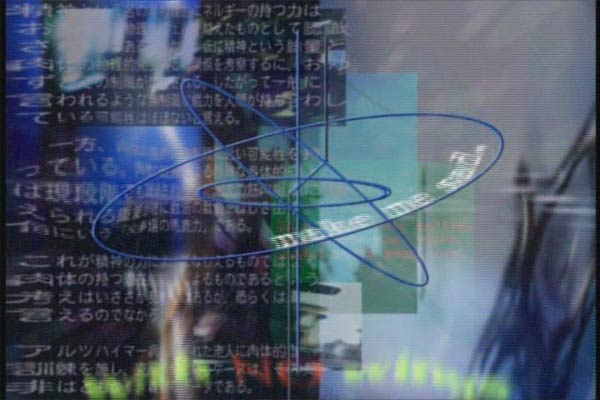
The Bottom Line: In the end, we are left with very open-ended thoughts. Serial Experiments Lain does not provide us with answers, instead, it opens us up to questions. And while I might argue that the post-modern pacing got too circular in places, and that I might argue the same tale could have been spun in half the time, the overall effect is rather extraordinary.
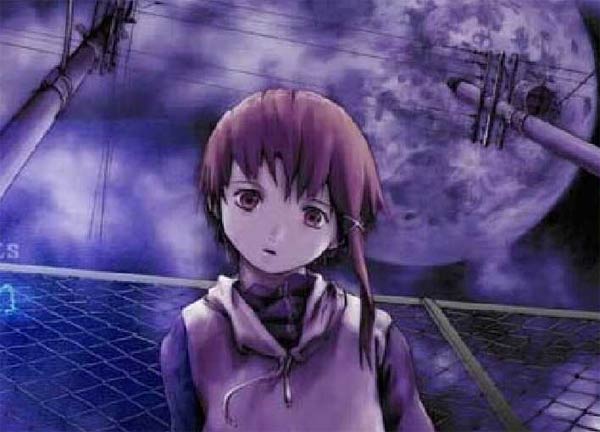
~See movies similar to this one~
Tags: cyberpunk movie review anime Serial Experiments Lain
Movie Review Status: So I’ve started getting reviews up. I have lots more reviews to upload (like 30-40 or so), but not all are in wonderful shape. I’m wondering whether I should get the reviews up first so that the movie link structure is more complete, and then just update the reviews as I go, or whether I should spend more time and get higher quality reviews up at a slower pace. Currently I’m leaning towards a slower pace - maybe 1 - 3 a day or so.
Site Development Status: I STILL have a ton of work to do, both in look and feel, and in functionality.
- At a minimum, I need to display some more of the categories on the left hand side, so that people have access to things like “surreal cyberpunk movies, android movies, animes, etc.
- An awesome graphic artist (Budo) has agreed to do a header graphic. Hopefully I can talk Budo into doing reviews as well.

- If you look at a single movie post, and go all the way to the bottom, you’ll see a set of categories that that movie resides in. I’ve been trying to figure out how to move that over to the sidebar for single posts, but up until now, I’ve been too stupid to figure this out. Then again, maybe it works better on the bottom. Maybe I just figure out a way to put a hyperlink anchor to take the user down to there.
- I have to put a list of credits in the footer to list all the wonderful plugins I’m using
- I need to decide what to put in the header. I think I’m going to remove the movies by decade link and just leave this on the right, unless someone tells me this is a bad idea.
- Currently, I have my site using the default setting for comments, which is “moderated.” Is this a good idea? I hear spam is a monster. Hmm…I may keep this also unless someone tells me otherwise.
Movie Categories: Currently I have one category grouping called “cyberpunk themes” that has the following sub-categories:
Alien movies
Dystopic future movies
Hacker movies
Hot cyberchicks kicking butt movies
Man-machine interface movies
Surreal cyberpunk movies, and
Virtual Reality movies
I have another category called “Style” with the following subcategories:
Animes
Awesome cyberpunk visuals
“B” cyberpunk cinema (I haven’t put many reviews here yet, but suffice to say there are LOTS of these)
Good low-budget movies
Soft core porn cyberpunk flicks
I have a few problems here. First off, I’m not sure there is enough differentiation between the categories. To me these seem different, but I can certainly imagine a list with all of these from both categories included. Second, I feel these may not cover everything. For some movie reviews, I find myself not putting anything in one of the two categories - this makes me think that maybe I’m missing something. Most likely it’s the “cheesy but sometimes decent” middle movies that are too good to qualify as B cyberpunk, but aren’t good enough to be called good. The other easy example is only having one category for anime, versus having say “anime movies” and “OAV animes.”
Finally, whatever categories I come up with, I want these to be able to work for other cyberpunk genre stuff like books, graphic novels, and potentially music. I fully get though that the cyberpunk culture stuff will need its own category, as will related scientific fields.
Thoughts?
This post has been filed under Site Development by SFAM.
Year: 2004
Directed by: Kazuaki Kiriya
Written by: Kazuaki Kiriya et al.
IMDB Reference
Degree of Cyberpunk Visuals: Very High
Correlation to Cyberpunk Themes: High
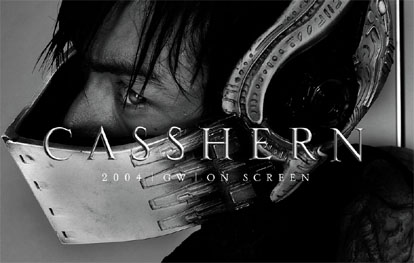
Overview: Like Immortel and Sky Captain, Casshern was one of the first movies filmed entirely on Blue or Green Screen. Casshern is by far the most ambitious of the three movies in terms of story complexity, symbols and messages conveyed, and in the scope of experimentation with visual effects. Unlike Sky Captain, this is NOT a feel-good Raiders-like fun romp. And unlike Immortel, which is also complex in scope, Casshern largely meets its intent from a story perspective. While Casshern is philosophically dense (I haven’t seen the anime yet, is it philosophically dense as well?), it does have some terrific action sequences. One of the best samurai sword duels I’ve seen happens here, as does some terrific robot vs. human fights. With its hard rock accompaniment, the action is almost matrix-like in quality.
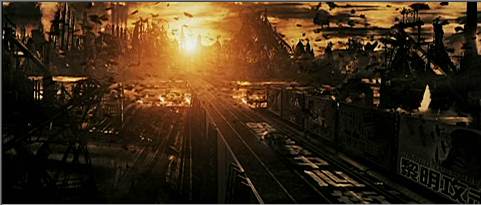
Casshern takes place in a very mechanized dystopian alternate future, in which the forces of Europa and the Greater Eastern Federation have been fighting a 50 year war for dominance. The Greater Eastern Federation has finally established control over the Eurasian continent, and now has to deal with the horrid side-effects the endless years of a chemical, biological, and nuclear war. The earth’s environment is in shambles, most of civilization has been wiped out and people usually wear protective masks when venturing outside.
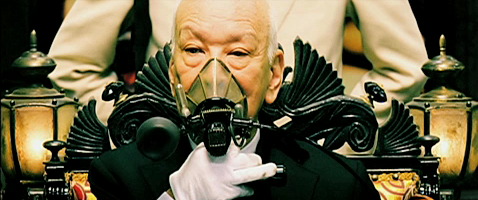
Its in this environment that Dr. Azuma, a genetic scientist, comes up with a solution to the maladies. He says he has discovered special “neo-cells” that can regenerate human tissue, and in effect, can create “replaceable parts” for the human body. An aging General with serious health problems jumps on this solution and sets Dr. Azuma up with a lab funded by the military. Casshern centers around the life of Dr. Azuma’s son Tetsuya, who in rebelling, decides to join the army. Unfortunately, he finds out that war is truly hell, and eventually ends up dying. His ghost comes back to say goodbye to his mother and fiancee, but things don’t go as planned. Unfortunately, Dr. Azuma’s research is not going very well. To extract more “Neo-cells,” the military ends up engaging in ethnic cleansing of the oldest part of Eurasia - sector 7. They bring back the body parts for the good doctor to use in extracting the Neo-cells.
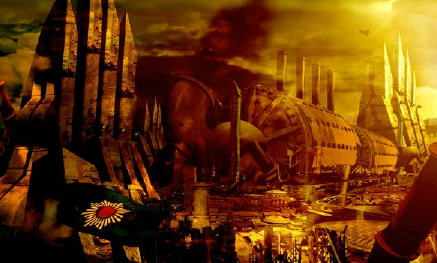
We find, however, that Sector 7 is inhabited by an ethnic group who were devout followers of a Gaurdian Spirit called Casshern. Casshern decides to make his presence felt and sends his lightning bolt down from the heavens, right into Dr. Azuma’s lab, and gives the Neo-cell “pool” the ability to bring the dead body parts back to life. After massive amounts of zombie-like people (later referred to as neo-sapiens) emerge from the pool (sparking the military to go all out in killing them), Dr. Azuma gets the idea that if he places his son Tetsuya in the pool, he will come back to life as well. This works, and Tetsuya gets reborn, but as a faster, stronger version of himself, just like the newly formed “neo-sapiens.”
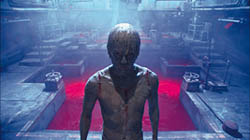
After the military hunts down and kills virtually all of the neo-sapiens, the few remaining Neo-sapiens escape to Sector 7, and after a cry for help, their prayers are answered when the Gaurdian Casshern sends them down an ancient stronghold, completely with robot warrior making capabilities. The rest of the movie involves the ongoing conflict between the Neo-sapiens and the Greater Eastern Federation, and the role that Tetsuya (who later takes the name Casshern when defending the local people) and his family plays in it. There is also a really nice love story that takes place between Tutsuya and Luna. They apparently have been fated for one another since birth, and will continue to be together throughout time.

The Visuals: Casshern has some of the most astounding visuals on film. More impressive is the use of various color palettes and textures to represent various themes in the movie. Death is represented by streaking white aura around a person; war is represented in a black and white pixilated look; Impending doom is represented in yellow; green represents life; the Neo-sapiens have the dark blue and bright red colors, etc. Truly, the diversity in visual effects is the strong highpoint of the movie. Also, I found the choice of music accompaniment consistently terrific. The choices really add to the mood. Combined with the astounding visuals, we really get a tour-de-force type “blow you away” affect. . Casshern is also heavily laden with symbols and philosophical meaning. In addition to having a strong antiwar and anti-technology message, Casshern gives us interesting religious musings, and some thoughts on implications for cheating death, and a pretty powerful message for the need for co-existence with others. Most interestingly, Casshern is able to show pain and suffering on the individual “little person” level, and show how this affects the large scale picture.
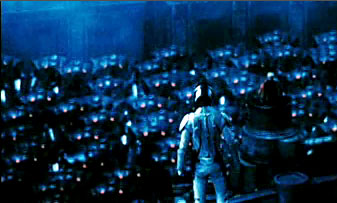
Overview: While difficult to understand (let me know if you want me to post a “page 2 spoiler” on this to explain it - it really is a very cool story), Casshern is simply an awesome picture that will develop a huge following over the years. Take the time to understand this, and you should love it. It is NOT a happy picture though, and is very emotional in tone.
~See movies similar to this one~
Tags: cyberpunk movie review
Year: 1990
Directed by: Yoshiaki Kawajiri
Written by: Akinori Endo (writer), Jyuzo Mutsuki (story)
IMDB Reference
Degree of Cyberpunk Visuals: Medium
Correlation to Cyberpunk Themes: Medium
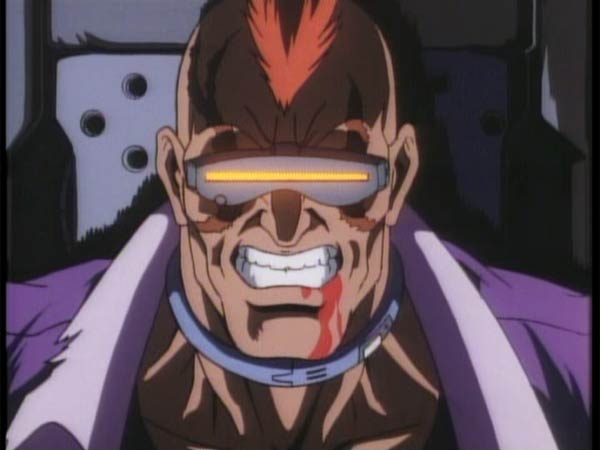
Overview: Cybercity, directed by the same guy who did the Marathon sequence in the Animatrix, is a pretty fun, but dated cyberpunk anime from 1990 that centers on 3 ultra-tough criminals who agree help the police kill the bad guys. They get these explosive collars installed (see above) and are given time limits for each mission - if they exceed the time limit - BOOM! There goes their head!
There are three stories on the DVD that I have - each centering on one of the three heroes. The stories aren’t that bad, and some of the animation is fairly decent considering the time. LOTS of shots have the US 80s cartoon look, but every now and then, you find some pretty cool cyberpunk visuals thrown in the mix. Here’s a sampling of some of the better visuals:

This guy stayed alive simply to get revenge on someone…
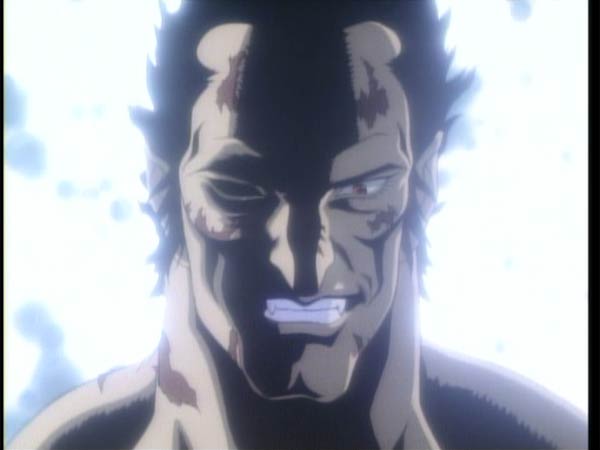
They even have a vampire villian episode!
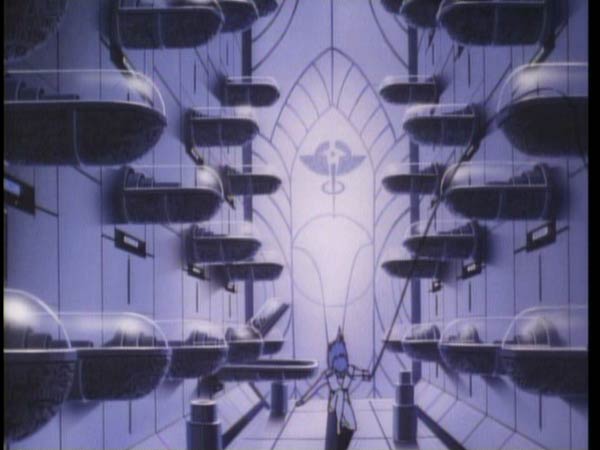
There’s an evil cat that pops out of one of these who tries to kill our transvestite hero.
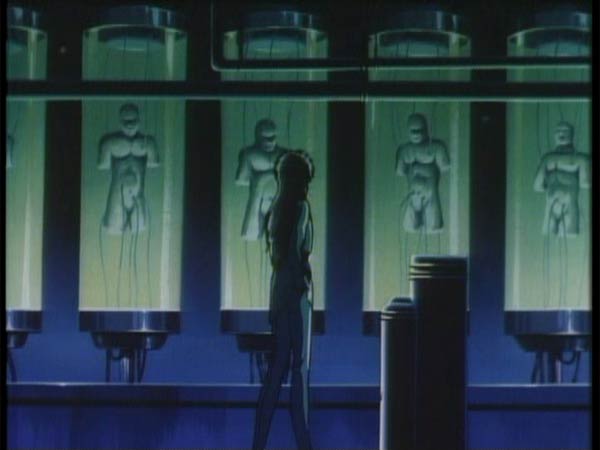
Your everyday average cyborg factory…
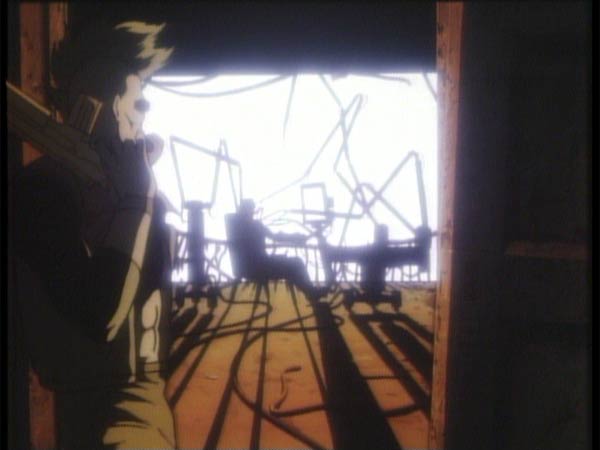
And of course, a criminal attempting to take his collar off…Good thing he wasn’t one of the main characters!
The Bottom Line: Again, nothing spectacularly breathtaking from either a visual, story, or philosophical standpoint, but this is clearly a decent low-budget attempt. Give it a try if you’ve got nothing better to watch. By the way, if someone knows where I can get the rest of the shows (assuming there were any), please let me know, as I’ve only seen the first three.
~See movies similar to this one~
Year: 1992
Directed by: Brett Leonard
Written by: Brett Leonard, Gimel Everett & Stephen King (original short story, but who filed a lawsuit to have his name disassociated from this)
IMDB Reference
Degree of Cyberpunk Visuals: High
Correlation to Cyberpunk Themes: High
Key Cast Members:
Dr. Lawrence Angelo: Pierce Brosnan
Jobe Smith: Jeff Fahey

Overview: Pierce Brosnan as 007 stars in this scifi espionage flick about a guy with a lawnmower who tries to take over the world…Well, that’s not exactly it, but close 
This might be another one of those I’m out to lunch on, but I’m guessing most have seen this flick. Lawnmower Man was originally derived from a Stephen King novel (although considering that King sued to have his name removed, we might infer he wasn’t thrilled with this movie), and is about a genius government funded scientist (Brosnan) who’s doing research on increasing human intelligence through using drug-assisted virtual reality experiments. His research, originally done on chimps, was cut off when a chimp goes wild, so instead of giving up, he does the research in his basement, using the local lawnmower dullard as his test subject.
Over time, the Lawnmower guy becomes awesomely intelligent, so much so that he grows more powerful than anyone could have possibly imagined. So much so, in fact, that he becomes a potential threat to mankind!
The Bottom Line: Lawnmower man is an early entree into 3D graphics. The graphics were rather decent at the time but certainly looks dated now. It’s still a nice scifi thriller that fully qualifies as a cyberpunk movie in every way possible. I enjoy this, and generally like Brosnan movies, but maybe its just a guilty pleasure of mine. Whereas I find it watchable in a cheesy sort of way, I can certainly imagine others scoffing at some of the insane plot points (like going from a multi-million dollar a year funded defense project, to getting better results in your basement). But even if you find this one watchable, it’s a pretty clear bet that you won’t stand a chance at liking the sequel.
~See movies similar to this one~
Tags: cyberpunk movie review
Year: 1987
Directed by: Steve De Jarnatt
Written by: Michael Almereyda, Lloyd Fonvielle
IMDB Reference
Degree of Cyberpunk Visuals: Low
Correlation to Cyberpunk Themes: Low
Key Cast Members:
Glu Glu Lawyer: Laurence Fishburne
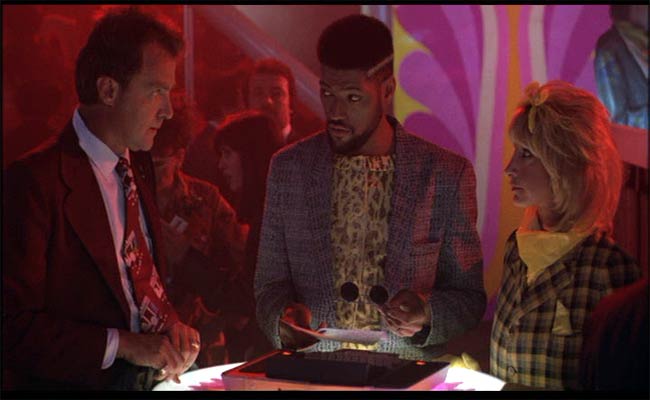
Overview: Cherry 2000 is about a guy named Sam Treadwell (David Andews) who gets too hot and heavy with his perfect android wife while wallowing in soap suds - unfortunately Cherry 2000 doesn’t take to water well and gets fried. After trying his hand at post-modern dating, Sam decides he needs a new body for his Cherry chip - unfortunately the only place they exist now is in a wasteland ruled by thugs. Sam hires Melanie Griffith as his tough-chick guide to navigate through the wasteland to get his new girl.
Truly, the majority of the movie is just not that good. In fact it’s worse than not good, and passes the border to unwatchable. The acting is absolutely horrendous, as are the outfits (intentionally though), as are the set pieces, as is the dialogue, as is the pacing, etc.
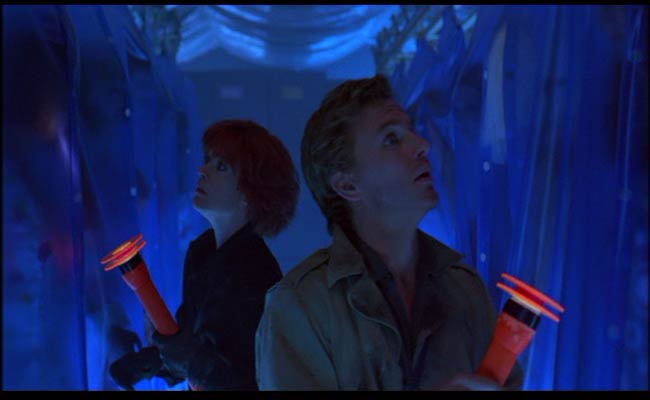
The Bottom Line: If you want to see Melanie Griffith’s worst acting performance, get Cherry 2000. But truly, the reason you might want to get this is, aside from the cool fried cyberchick love scene at the beginning and maybe the “select a love-babe” scene, is for Cherry 2000’s most awesome commentary on dating in the future. Dating in the future requires a lawyer (played wonderfully by Lawrence Fishbourne - the ONLY performance in the movie that shined) and LOTS of negotiations. That scene alone, also thankfully right near the beginning, is almost worth the price of the movie.
~See movies similar to this one~
Tags: cyberpunk movie review
WordPress database error: [You have an error in your SQL syntax; check the manual that corresponds to your MySQL server version for the right syntax to use near '' at line 1]
SELECT COUNT(ID) FROM
|


































